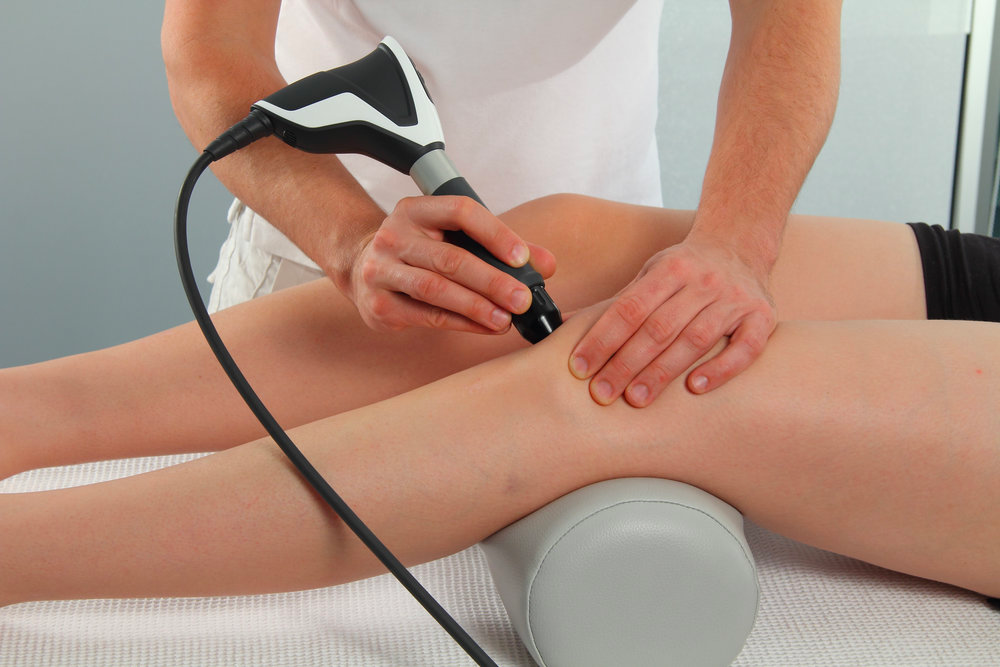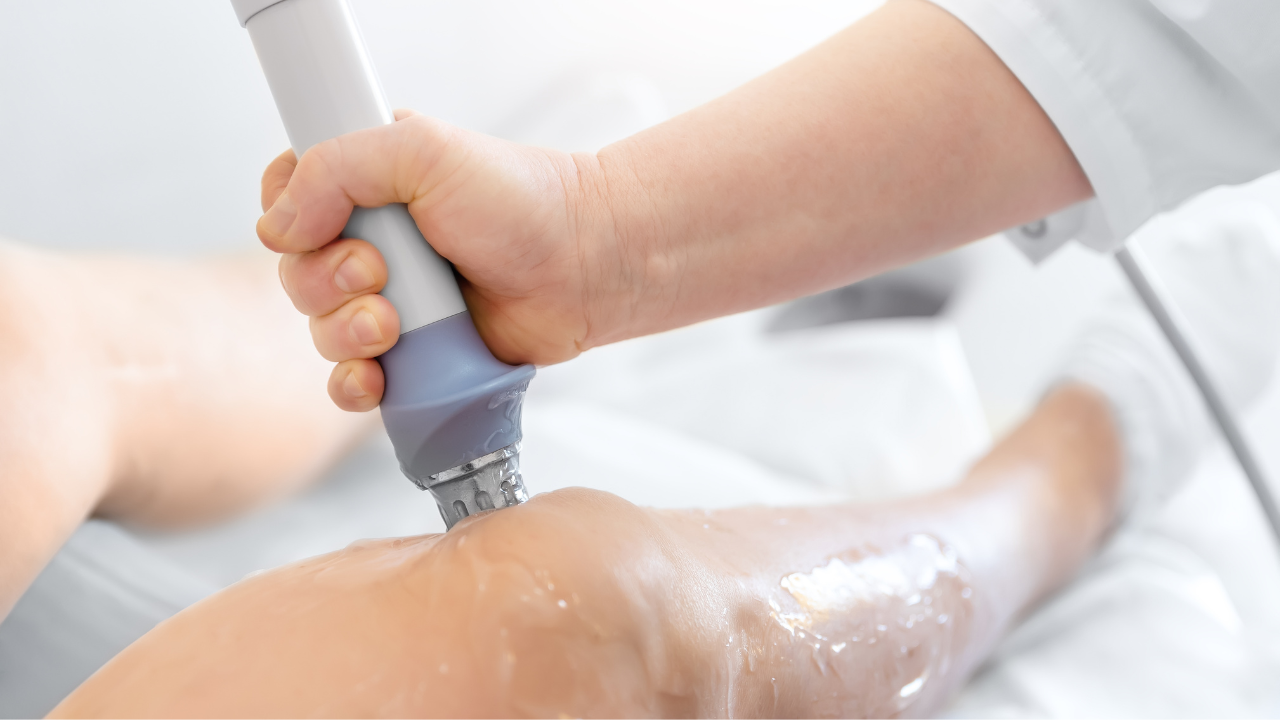How Extracorporeal Shockwave Therapy (ESWT) is Used in Physiotherapy
By Nigel ChuaIn recent years, physical therapy (physiotherapy) has witnessed tremendous advancements in therapeutic techniques to reduce chronic and acute pain, accelerating healing and promoting recovery.
Among these cutting-edge approaches, shockwave therapy treatment has emerged as a promising non-invasive treatment option for various musculoskeletal conditions.
Shockwave therapy was first used for treating soft tissue injuries in Singapore about ten years ago but has been approved by the FDA since 2002.
In this article, we will delve into the fascinating world of shockwave therapy and explore how it is being used in modern physiotherapy.
What is shockwave therapy?

Shockwave therapy, also known as Extracorporeal Shock Wave Therapy (ESWT), is a medical procedure that involves the application of high-energy shockwaves to affected areas of the body.
These shockwaves are sound waves generated externally and are transmitted through the skin to targeted tissues via a coupling medium, such as ultrasound gel.
ESWT treatment is based on extracorporeal shock wave lithotripsy (ESWL), which was used to treat kidney stones and gallstones.
However, ESWT uses lower energy levels when treating musculoskeletal disorders, stimulating cell repair, enhancing blood circulation, and accelerating and enhancing the body's healing process.
What types of extracorporeal shockwave therapy (ESWT) are there?
There are primarily two types of ESWT treatment.
The choice between the two types of shock wave therapies usually depends on the type and location of the injury or condition, the patient's tolerance to pain, and the desired result of the treatment.
Focused Shock Wave Therapy (FSWT)
FSWT uses a single acoustic pulse that is concentrated on a specific point.
This type of shockwave therapy is generally used for deep tissues and can be tailored to reach specific depths and intensities based on the patient's condition.
FSWT follows an electroacoustic principle, using electromagnetism and coupling pads to apply deeper, focused and adjustable waves.
Focused shock waves allow for ‘adjustable’ penetration depending on where needs to be treated and are ideal for treating deeper problem areas such as hamstring, pelvic or hip issues.
Focused waves are characterised as having a higher maximum intensity, delivered as a convergent wave with an adjustable depth of focal area. This can range between 2 and 30cm - this is quite deep, and our muscles, tendons and joints arent that deep.
Radial Shock Wave Therapy (RSWT)
In RSWT, the shock waves spread out radially from the point of application. This type is usually used for treating superficial tissues and is generally less intense than FSWT.
RSWT follows a pneumatic principle, using compressed air and transmitters to determine the wave shape
Radial shockwave therapy have a lower maximum intensity and deliver the shock waves up to 4 cm depth.
How does shockwave therapy work?

Some of the key mechanisms involved in the action of shockwave therapy include:
Neovascularisation: Shockwaves stimulate the formation of new blood vessels, improving blood flow to the injured area and enhancing tissue healing.
Cell Growth and Proliferation: The mechanical energy from shockwaves can break down scar tissue and promote cell growth production, leading to the proliferation of cells essential for tissue repair.
Pain Reduction: Shockwave therapy can inhibit pain receptors and reduce pain transmission, relieving patients suffering from chronic pain conditions.
Collagen Production: The treatment stimulates collagen synthesis, which is vital in restoring the structural integrity of tendons, ligaments, and other connective tissues.
What is extracorporeal shockwave therapy used for in physiotherapy?
Extracorporeal shockwave treatment can modify how pain is experienced, mend tissue, and increase the body's natural inflammatory healing process.
These effects are both physical and cellular in nature. The cells can then regenerate from these signals, allowing for healing.
Some of the common applications in physiotherapy include:
Tendinopathies

Radial shockwave therapy has been highly successful in treating chronic tendinopathies, such as
- tennis elbow (lateral epicondylitis: on the outer side of the elbow)
- golfer's elbow (medial epicondylitis: on the inner side of the elbow)
- Achilles tendonitis (tendon of the heel)
- patellar tendinopathy (tendon of the knee cap)
By stimulating tendon healing, ESWT treatment provides rapid pain relief and tendon healing, which allows us to help patients return to their daily activities quicker.
Plantar Fasciitis

Shockwave therapy is a game-changer for individuals suffering from the excruciating pain of plantar fasciitis.
By promoting tissue regeneration in the plantar fascia, patients experience significant pain relief and improved mobility. What most patients are happy is that their plantar fasciitis pain is healing with shockwave treatment.
Calcific Shoulder Tendinopathy
This painful shoulder condition is characterized by calcium deposits in the shoulder tendons and can be challenging to treat.
Shockwave therapy with our physiotherapists has emerged as a promising non-surgical option to break down these calcifications, rapidly reducing pain and improving shoulder movement, strength and function.
Stress Fractures

Shockwave therapy can accelerate the healing process of stress fractures by stimulating bone cell activity and improving blood flow to the affected bone injury or contusion areas.
Myofascial Trigger Points
Myofascial trigger points are very tight knots in the muscles that can be very painful, even "travelling or radiating" upwards or downwards.
For example, a trigger point in the upper shoulder can radiate pain upwards, causing headaches, or radiate downwards into the arm and hand.
Shockwave therapy can be a highly effective treatment option for patients with chronic muscle pain and trigger points, providing rapid pain relief and promoting muscle relaxation.
Experience a better recovery journey with Phoenix Rehab!
Our team of expert therapists use an integrated, multidisciplinary approach to rehabilitation. At Phoenix, we believe everyone should have access to the best care available.
Our skilled multidisciplinary team of senior principal physiotherapists, hand therapists and other health professionals is here to prevent, assess, and treat various movement disorders caused by physical disabilities, sports injuries, or illnesses.
No matter your health or recovery goals, we are there every step of the way to ensure you receive dedicated and personalised treatment on your path to recovery.
Step into a world of renewed vitality and let our dedicated physiotherapy team guide you towards optimal health.
Book your appointment today!
Browse other articles by category
 PHYSIOTHERAPY
PHYSIOTHERAPY
 Hand Therapy
Hand Therapy
 Alternative
Alternative
 Massage
Massage
 Traditional Chinese Medicine Treatment
Traditional Chinese Medicine Treatment
 Rehab
Physiotherapy For Upper Back Pain
Physiotherapy For Shoulder Pain
Physiotherapy for Knee Pain
Physiotherapy For Slipped Disc
Orthopedic Doctors, Insurance & Healthcare
Rehab
Physiotherapy For Upper Back Pain
Physiotherapy For Shoulder Pain
Physiotherapy for Knee Pain
Physiotherapy For Slipped Disc
Orthopedic Doctors, Insurance & Healthcare
 Physiotherapy For Lower Back Pain
Physiotherapy for Neck Pain
Frozen Shoulder
Physiotherapy for Back Pain
Physiotherapy For Lower Back Pain
Physiotherapy for Neck Pain
Frozen Shoulder
Physiotherapy for Back Pain

 Whatsapp us now
Whatsapp us now